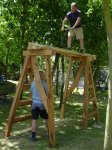Well, I am doing a bit of work at Helston museum.
Im looking over their tool displays, making sure everything is in the right place and considering how to improve them.
I am probably the wrong person for this as I already know what most are and what they do.
We have a huge saw, from a sawpit, and I said we need a sawpit picture to give the public an idea as to how it was used.
Anyone worked a sawpit and have you got pictures?
Im looking over their tool displays, making sure everything is in the right place and considering how to improve them.
I am probably the wrong person for this as I already know what most are and what they do.
We have a huge saw, from a sawpit, and I said we need a sawpit picture to give the public an idea as to how it was used.
Anyone worked a sawpit and have you got pictures?




